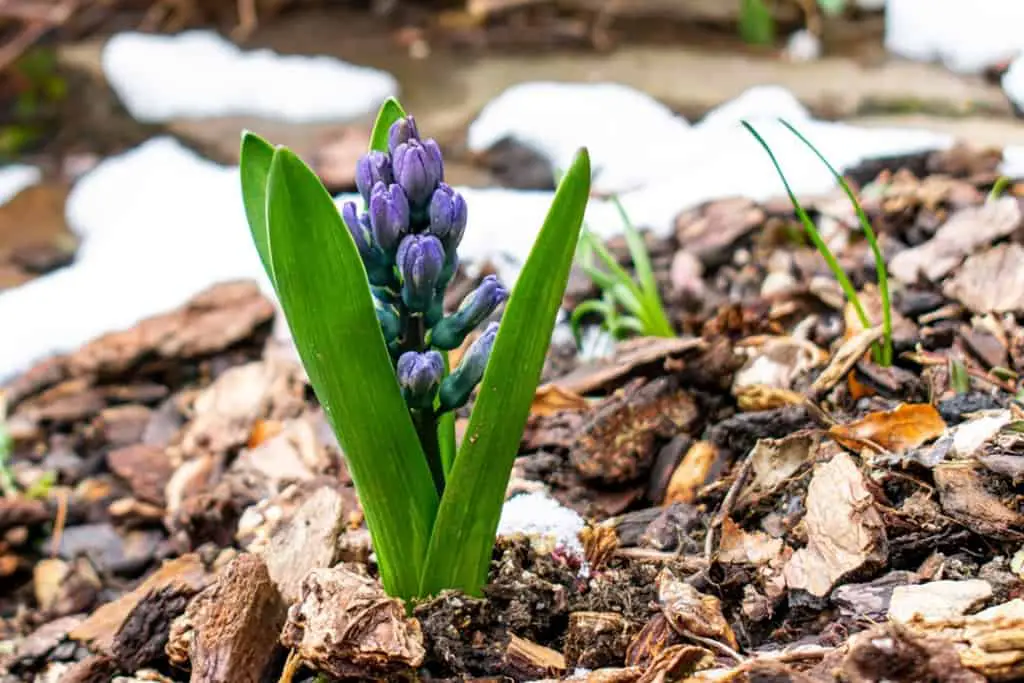We use mulch to protect and nourish the soil and help the plants that we are growing. This article will explain how to mulch properly, why it’s worthwhile, and how to make your own mulch from your lawn’s clippings.
What is Mulching?
Mulching is the process of covering the soil with organic materials. Gardeners have copied this principle from the wild because there is practically no bare soil in nature anywhere. Leaves, broken branches, plants, or a humus layer usually cover the ground everywhere. This layer protects the plants and also provides them with nutrients.
What are the Benefits of Mulching?
Your garden’s soil is exposed to many external forces like wind, temperature changes, and drought. Therefore it makes sense to apply a protective layer on top — the so-called mulch. If you mulch properly, the soil stays moist, the wind can’t dry out the soil, water doesn’t evaporate as fast, and the mulch protects the soil from rain erosion.
The mulch layer also acts as a warming blanket, prevents weeds, and can accelerate your plants’ growth. In the case of fruit and vegetable plants (especially warmth-loving ones), mulch has been proven to increase the yield.
Mulch also encourages soil health by supporting a diverse assortment of worms, bacteria, and microorganisms that loosen the soil under the mulch and break down the organic cover. This makes the humus layer grow and enrich the soil with nutrients. Manual watering and cultivation become things of the past with a well-mulched bed.

How Can I Make Mulch?
Mulch is mostly made up of organic materials – which means you can easily make a proper bed cover yourself. If you have a lot of garden waste like hedge or lawn clippings, you can use them to mulch your bed. In autumn you can also use leaves and straw.
However, you should only apply thin layers of rich materials like lawn clippings so that they can decompose evenly. Thick, wet piles of lawn clippings aren’t doing you any good; layer your yard compost throughout the bed. Shredded wood scraps or chopped straw, or ornamental grass stems are other materials you can use, especially for fruit trees and berry bushes, as they like warmer environments.
If you have a lot of wood waste in your yard from pruning trees, for example, then you can shred it in a chipper. However, keep in mind that the wood chippings bind a lot of nitrogen and may lead to short-term soil deficiency until they decompose. Once again, it is all about diversity and layering.
If you have a snail problem, you might need to use reeds as your mulch material, which will help you keep them away. Shredded herbal plants are another excellent material for keeping pests at bay.
Finally, always try to add compost to the soil each planting season because it acts as a fertilizer, and it promotes soil microbes that aid plant growth. Thin layers of compost applied all year round will mimic how nature applies leaves and plant debris to the soil surface.
Best Mulch Products
If your mulch production is too time-consuming or your garden waste is not enough, you can always buy it from your local gardening store.
Bark mulch is especially popular because it is suitable for shrubs and hedges and effectively suppresses weeds. The shredded tree bark can also act as an excellent surface for your garden paths.
Wood chips are sometimes referred to as mulch as well and can be purchased in many wood varieties and coarseness. Often, the very course chipper chips can be had for free from a local town or tree trimmer who needs to get rid of the chips from their work. Be aware that the more course your chips are, the longer they will take to decompose. Shredded mulches will decay much more quickly than chips.
Alternatively, you can also use gravel or stone as a soil cover, which will help to shade the soil from the sun and may retain some moisture and help to keep the weeds down., but rocks aren’t technically mulch since they don’t decompose and turn to soil over time.

How to Mulch Properly
Before you apply the mulch to your beds, you will likely want to remove any weeds present or cover the weeds with a biodegradable material such as newspaper or cardboard.
You can then start spreading the mulch. Make sure you apply the material around the plants but keep the mulch very thin near the plant’s stem. Piling organic material against the stem of a plant will cause rot and will also encourage rodents to spend the winter there eating the stem of your plant.
As you move away from your plants’ stem, you can get thicker and thicker with your mulch. Put maybe 2-4 inches anywhere that the plant roots are, and feel free to go thicker in bare open soil areas. Thicker mulch will discourage weeds. The mulch should be lying loose and not be worked into the soil.
It is best to have the ground covered all year round. There is no right or wrong time to mulch. In winter, the straw or foliage mixture offers protection against frost and rich nutrients for your plants in the summer.
If you have freshly sown beds, wait before mulching. Thick mulch cover over seeds or tiny plants will surely reduce plant growth. Once your seedlings are about four inches, you can safely cover the soil up to the leaves’ base.
Mulching with Lawn Clippings
Lawn clippings, which can be found in most gardens anyway, are an excellent mulching material as long as the blanket is not thicker than an inch. The finer the cut of grass is, the better for the soil. After all, long stalks are difficult to decompose.
For the most part, you will want to use a mulching mower and leave your clippings on the lawn to help enrich that soil, but if you do collect grass clippings, you can definitely spread them on your beds as mulch. As mentioned before, just keep the layers thin and mix with various other organic materials.
Final Words
Mulching is an essential part of gardening as it benefits both your growing plants and your soil. When you mulch your beds, you will not need to water, fertilize, or remove weeds as much. The plants benefit from the warming layer and the nutrients released as the materials decompose. Mulching is also practical because you can recycle your garden waste while doing it. Why do so many people pay their landscapers to haul away leaves and yard debris in the fall and then pay them again in spring to bring wood mulch into their beds? It makes no sense.

